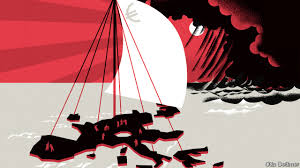The euro area is back on the brink of recession

IT BEGAN AS a joke: the Twitter hashtag #euroboom tacked on to news of any sign, no matter how faint, of a euro-area recovery. By 2017, when French, German and even Spanish GDP grew by more than 2%, it seemed to describe a real phenomenon. Alas, all too quickly #euroboom has turned to #eurogloom. GDP data scheduled for release later this month are likely to confirm that in the final three months of 2018 Italy’s economy contracted for a second consecutive quarter, satisfying one of the technical definitions of a recession. Germany appears to have escaped recession, but only just. The euro area, formed in January 1999, may pass its anniversary on the brink of another downturn.
The euro has been an economic fiasco. GDP growth in the euro area has lagged behind that in other advanced economies, and in the European Union as a whole, throughout its life—before the financial crisis, during the global recession and its euro-area encore, and even during the recent #euroboom. Perhaps the area would have done as badly without the single currency. But attempts to estimate euro-zone performance relative to a counterfactual world sans euro suggest not. The past decade has been especially brutal. A list of the world’s worst performers in terms of real GDP per person since 2008 contains places suffering geopolitical meltdowns—plus the euro-area periphery. Greece has been outgrown by Sudan and Ukraine. Cyprus and Italy have been beaten by Brazil and Iran; France and the Netherlands by Britain.
And now the euro area begins its third decade, a new slump looming. It has many causes. German car production slowed as firms worked to meet new emissions standards. Italy’s economy wobbled as its new populist leaders battled with Brussels, spooking markets. Protests threw a wrench in the gears of the French economy. China’s slowdown and straitened global financial conditions took a toll. But although the specific forces dragging down euro-area growth might not have been foreseeable two or three years ago, an eventual return to gloomy form should have been.
The euro zone’s economies labour under plenty of structural hindrances to growth. But since 2008 their main constraint has been weak demand. After the global crisis growth briefly revived, only to swoon again because of institutional weaknesses. Investors fretted that the European Central Bank (ECB) would not stand behind nationally issued bonds or deposits at nationally insured banks, and panicked accordingly. Fear subsided as European leaders moved grudgingly to create supranational stabilisation mechanisms, allowing the ECB to promise to support national bonds and banks. Growth remained weak, however, despite the ECB’s decision in 2015 to begin an open-ended programme of stimulative bond purchases, like those started elsewhere long before.
Then came the #euroboom. If reform and ECB action cleared away obstacles to growth, it was demand imported from abroad that rescued the euro area from its doldrums. From 2013 to 2016 net exports contributed substantially to growth; the euro area’s current-account surplus leapt from roughly 1% of GDP to nearly 4%. As a recovery in export industries reduced unemployment, domestic demand played a bigger part in boosting growth. In 2017 and the first half of 2018, consumption contributed more than two percentage points to growth in GDP. Investment chipped in another percentage point. The euro area was lucky. Had China’s government not flooded its economy with stimulus, or had America not supported global production by running vast trade deficits, then the boost to demand needed to put Europeans back to work, and get them spending again, might never have materialised.
That is because Europe’s crisis-era reforms also included draconian measures to limit government borrowing. The price of German support for crisis-addled economies was a revision to the “stability and growth pact”, which is intended to keep budgets in line. The new fiscal compact struck in 2012 requires governments to keep net borrowing to no more than 3% of GDP. Though that may not seem particularly onerous, it also requires them to maintain a structural budget deficit (adjusted to take account of the business cycle) of no more than 1% of GDP if debt is “significantly” below 60% of GDP, and no more than 0.5% of GDP if debt is above that level. Governments with debt above 60% must also take steps to bring it back below that threshold; those approaching it can no doubt expect stern warnings. Countries in egregious violation of these rules are subject to penalties. In Italy, which has public debt of around 130% of GDP, populists were carried into office by frustration with the status quo, but cowed into budget sobriety last year after the EU threatened to impose such penalties.
#eurodoom
In effect, Europe has denied governments the ability to use their budgets to boost demand. These fiscal shackles would be less worrying if the ECB were better positioned to boost private spending by easing monetary policy. But its effective interest rate is already negative. The slowdown in 2018 came despite the ECB asset purchases continuing, albeit more slowly than in 2016 and 2017. Foreign spending could keep the euro-area economic engine turning over. But it is fickle, as the currency bloc is learning. It was only a matter of time until an ill wind caused the euro area’s sails to slacken, exposing its inability to maintain domestic demand without external help. The shift from boom to gloom was inevitable.
It need not be permanent. Europe could loosen its fiscal restraints. Better still, it could make use of its combined fiscal potential by mutualising some debt and creating a euro-area budget big enough to offer meaningful stimulus. These reforms would require a big shift in the balance of power and thinking within Europe. Such shifts have occurred before, in the throes of crisis. But if the past ten years of #eurogloom did not demonstrate the pressing need to maintain an array of demand-boosting tools, it is difficult—and frightening—to contemplate what ultimately will.





